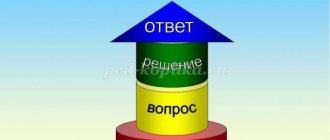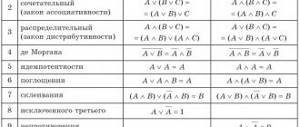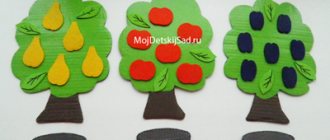Working on a problem in elementary school.
Working on a problem in elementary school
- The role and functions of word problems in learning.
In the context of the system of Federal State Educational Standards requirements, the teacher is faced with a task of extreme importance: to ensure that each student grows up not only well-mannered, educated and healthy, but also necessarily proactive, thinking, capable of a creative approach in any matter, including research. The development of such qualities is facilitated by problem solving. And also the ability to solve problems, including text ones, is one of the main indicators of the depth of students’ assimilation of educational material and the level of mathematical development.
Problems are a means of developing logical thinking, show the importance of mathematics in everyday life, and help children use the acquired knowledge in practical activities. Leading methodologists note that solving word problems in elementary school has a dual goal: on the one hand, to teach how to solve word problems of various types, on the other hand, the word problems themselves act as a means of teaching, educating and developing schoolchildren.
However, unfortunately, until now, most often, to teach children to solve problems, teachers only use showing ways to solve certain types of problems and reinforcing their solutions mechanically, although solving problems is designed, from the first steps of getting to know them, to develop logical thinking, ingenuity, and ingenuity ; in working with problems, logical skills are improved to carry out analysis and synthesis, generalize and specify, reveal the main thing, highlight the main thing in the text and discard the unimportant, secondary; cultivate personal qualities - patience, perseverance, will.
It should also be noted that often when solving problems, students also awaken interest in the very process of finding a solution; when they achieve a goal, children receive moral satisfaction (if work on the task is properly organized). When solving problems, children of different ages gain new knowledge, generalize and systematize what they have previously acquired. In accordance with the current curriculum in primary school, all arithmetic operations are introduced precisely in problems, i.e. the formation of the specific meaning of arithmetic operations (the concept of addition, subtraction, multiplication, division) occurs precisely in the process of solving problems. Problem solving also improves students' computing culture. In the process of solving word problems, students develop skills in modeling real objects and phenomena, translating real life situations into mathematical language.
At the first level school the foundation of knowledge is laid,
skills and abilities of students, necessary not only for their further education, but also for the development of mental, moral and emotional-volitional qualities of the students’ personality. The course in elementary mathematics has a pronounced practical, educational and cognitive orientation, and contributes to the formation of generalized techniques of mental activity of students.
2. The concept of a simple and compound problem.
Task
is a verbal question, the answer to which can be obtained using arithmetic operations. A problem consists of a condition and a question that requires finding an unknown or unknowns.
Text arithmetic problems are divided into concrete and abstract.
For example:
1. In the morning, students handed over 10 books to the library, and in the evening - 14 more books. How many books did the students check into the library for the whole day? (Specific task).
2. Find a number that is greater than 12 by 5. (Abstract problem).
Mathematicians divide problems into simple and compound (complex) based on the number of arithmetic operations performed. A simple task is a task that can be solved using one action, while a complex task is a task that can be solved using two or more actions. If it is impossible to select another task in a task, then it is a simple task; if it is possible, then it is a composite (complex) task. A compound problem can be decomposed into simple or composite subtasks, the solution of which leads to the solution of the main compound problem.
3. Types of simple tasks:
- to find the sum;
- to increase and decrease the number by several units;
- to find the unknown term;
- to find the remainder;
- to find the unknown subtrahend and addend;
- to find the unknown minuend;
- for difference comparison;
- with indirect questions.
4. Brief recording and other types of graphic work.
Some authors attribute the preparation of a short note to a problem to the stage of finding a way to solve the problem, and not to the stage of analyzing the conditions of the problem (M.A. Bantova). In my opinion, this is really so, because... compiling a short record of a problem often allows you to determine its solution (an implicit search for a solution). When working on a plan for solving a problem, the student must highlight all possible connections between quantities that can be traced in a given problem (even if they then do not need to be involved in the solution). While analyzing a problem, you can create an illustration for it. An illustration of a problem, a brief recording of it, a diagram or drawing, tables are auxiliary tools, but most often they help the student understand the meaning of the problem, identify dependencies between quantities and find a plan for solving the problem.
A short note, acting as a visual and verbal support for students’ memory, contributes to a faster and more comprehensive assimilation of the task and comprehension of numerical data. Isolating numerical data from the text and writing it rationally makes it clearer what is given in the problem and what is being sought in it. A short notation makes it possible to divide the problem into a condition and what is being sought, and facilitates the analysis of the problem.
However, it should be remembered that a short note serves the interests of the child in solving the problem, and not the goal in solving it (an auxiliary tool!!!). Therefore, when assessing the correct solution of a problem, one should not blame the child for the fact that he made a short note not according to the model shown by the teacher, but in a way that is convenient for him, the main thing is that the problem was solved correctly.
Types of short notes:
- drawing
- scheme
- drawing
- table
Methods for solving problems in elementary school
:
arithmetic
(by actions or using an expression)
, algebraic (using an equation),
graphic, practical
, logical
, mixed, tabular.
5. Ways to solve problems.
There are 2 types of problem analysis: synthetic
(reasoning must be carried out from the data of the problem to its question),
analytical
(from the question of the problem to the data).
When analytical
method of solving a problem, it becomes clear what needs to be known in advance in order to answer the question of the problem. To help children reason analytically, you can use a technique called a “reasoning tree.” Its essence is that in the course of reasoning, a diagram is constructed that helps to see which simple tasks should be identified and what the plan for solving this complex problem will be.
Synthetic
The method is characterized by the fact that the main question when searching for a solution to a problem is the question of what can be found from two or more numerical values known in the text of the problem. Using the newly obtained numerical values and other data known in the problem, the answer to the question of what can be learned from these values is again sought. And so on until the answer to the question of the compound problem. In other words, the essence of this method is to isolate a simple problem from the proposed complex one and solve it.
6. Stages of working on a task.
1) Preparation for solving the problem. Reading task.
a) Read the problem correctly: emphasize the numerical data and the words that determine the choice of mathematical action, such as “was”, “left”, “remained”, “speed”, “time”, “distance”, etc. .
b) Imagine the life situation described in the problem.
2) Finding a solution to the problem.
a) Select the data and the required numbers in the problem, establish a connection between them. To do this, answer the questions:
Who or what is this problem talking about?
What is said about these items?
What is the question?
b) Draw an illustration of the problem: this is either a drawing, or a diagram, or a drawing.
c) Repeat the illustration task.
3) Drawing up a plan for solving the problem.
Explain what you learn by doing this or that action. Reasoning can be built from the given conditions to the question. Reasoning can be built from the problem question to the given numbers.
4) Solving the problem.
You can write the solution:
a) by actions;
b) expression;
c) equation.
5) Checking the solution to the problem.
The mathematics program for primary grades focuses on the mandatory mastery of all students in various ways of testing the solution of problems. Work on developing control and self-control skills when solving problems is very important. After all, checking a solved problem allows you not only to verify the correctness of the solution, but also contributes to a deeper understanding and comprehension of its mathematical content, awareness of the connections between the quantities presented in the problem. However, as a rule, when checking the solution to a problem, only some students who lead the explanation take an active part. The rest take the position of passive listeners, or performers, even if they solved the problem incorrectly.
Learning to check problem solving is a full-fledged stage in teaching children to solve problems. It must be specially organized, carried out purposefully and systematically. Moreover, at the first stages of learning to solve problems, when children have not yet sufficiently developed control and self-control skills, it makes sense to invite students, after solving a problem, to check whether it was solved correctly.
To check the solution to a problem means to determine whether it is correct or incorrect.
You can check the solution to the problem in different ways:
a) Compose and solve the inverse problem, problems.
b) Solve the problem in a different way.
c) Compare the result obtained and the task data.
7. Follow-up and creative work on tasks.
I would like to note right away that many methodologists consider subsequent and creative work on tasks to be similar. In my opinion, this is not true. During the subsequent solution of work on a problem, you can perform creative tasks, but not all creative work on a problem is a subsequent solution.
When organizing students’ activities on a problem after solving it (subsequently), the following types of work can be used:
- an elementary study of the solution to the problem (under what conditions the problem has one or more solutions and no solution; how the answer to the problem will change if the data is changed, etc.);
- compare solutions to inverse problems, observe dependencies, etc.;
- change the task requirement so that the problem is solved differently;
- create another task on this issue;
- create a similar problem, but with different numbers and a different plot;
- change the requirement of the problem, but the solution to the problem would remain unchanged;
- draw up all possible requirements that can be set for a given condition, etc.
When developing skills for solving problems of this type, you can go in two ways: extensive (quantity) and intensive (quality). Unfortunately, teachers often waste time on subsequent work on the problem, solving inverse problems, working on deformed problems, preferring to practice skills in solving problems of the minimum program, i.e. go the extensive route. The choice of path (intensive - extensive) should be determined by the typological characteristics of students and vary for each group (see “Differentiated work on tasks”).
However, the main guideline in the work should be the intensive path. You can give the following example: in order for a child to understand what a “book” is, you can talk a lot about books, show their images, etc. Or you can simply give him a book so that he can hold it in his hands, leaf through it, examine its elements in detail, etc. In the second case, the concept of “book” will be formed. But in the first one it’s problematic. Same with tasks. Solving a large number of problems of the same type is good, but this does not mean that the child has developed a generalized way of solving this problem. And when solving inverse problems, deformed problems, transformation of problems, the student, as it were, considers the problem from all points of view, transforms it, analyzes and synthesizes it.
I will give examples of creative tasks that can be used at different stages of working on tasks.
- The condition “The boy bought 10 marks, and the girl bought 15” was given.
Which of the following questions can be posed to this problem:
a) How many stamps did the children buy together?
b) How many more stamps did the girl buy?
c) How many fewer stamps did the boy buy?
d) How much does one stamp cost?
2. Students are offered several texts of problems, several short notes and solutions. Assignment: for each problem, select its short description and solution. Solve the remaining problems. If you have a short note left, make up a problem based on it and solve it. The number of problems, short notes and solutions should not be the same. This will eliminate the “residual principle” of choice.
3. The text of the task and numerical expressions made up of the numerical data of the task are written on the card. Children are asked to choose those expressions or their combinations that are the solution to a given problem.
Conclusion:
I would like to end my article with the words of Bernard Shaw: “The ability to think mathematically is one of the noblest abilities of man.” This is the skill we, teachers, must develop in our students.
Setting Time Estimates
, you can enter Original Estimate for the task (that is, the total amount of time you think it will take to complete the task).
If work is first logged against a task, the Time Spent is subtracted from Original Estimate and the resulting value automatically appears in the Remaining Estimate . When subsequent work is logged, any Time Spent is subtracted from the Remaining Estimate .
However, throughout the lifecycle of an issue, you can manually change the Original Estimate and / or Remaining Estimate values . To do this:
1. Navigate to an existing task, view it, and click the Edit button at the top of the screen to edit that task .
OR
Create a new issue by clicking the Create Issue button at the top of the screen and fill out the required fields.
2. Edit the following Time Tracking fields:
- Original Estimate - of time that you initially consider necessary to solve the problem. This is typically specified when the task is created or before work on the task is first logged.
- Remaining Estimate - of time you think it will take to solve the problem in its current state.
You may only see one of these fields if JIRA Time Tracking is in Legacy Mode . If JIRA Time Tracking is in Legacy Mode and work on the issue has not yet been logged, you will see the Original Estimate "( Original Estimate ). However, once the job has been registered, you will only see the Remaining Estimate field .
change time tracking information in the Original Estimate and / or Remaining Estimate . Use "w", "d", "h" and "m" to indicate weeks, days, hours or minutes. For example, to specify "six o'clock", enter "6h".
If both of these fields are available and required (indicated by red asterisks), you can simply enter one value and leave the other value blank. When you submit the form, the value field will be copied to the field that is left blank.
4. Click the Update button at the bottom of the screen.
If you can't change the Original Estimate values for issues after work on them has been logged, but you want to do so, ask your JIRA admin to disable Legacy Mode when tracking time. If your JIRA admin has added the ability to specify/change time estimates on other workflow transition screens in the default JIRA workflow, you will also be able to specify/change time estimates during those workflow transitions.
Additionally, if your JIRA administrator has added this capability to JIRA screens used by other issue types, you can also provide time estimates when creating or editing those issue types.




